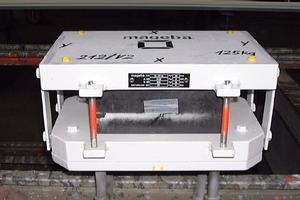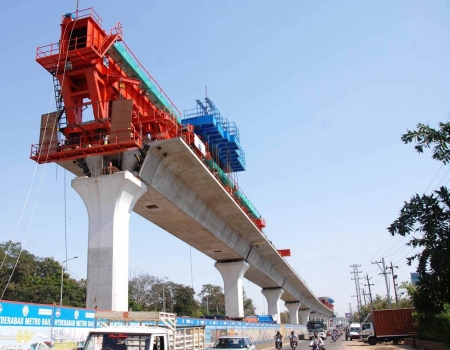General Information
| Completion: | 29 November 2017 |
|---|---|
| Status: | in use |
Project Type
| Function / usage: |
Metro (rapid transit) network |
|---|
Location
| km | Name |
Technical Information
Dimensions
| number of stations | 57 | |
| elevated length | 67.21 km | |
| system length | 67.21 km | |
| track gauge | 1 435 mm |
Case Studies and Applied Products

LASTO®BLOCK – Elastomeric Bearings
mageba elastomeric bearings, which conform to various international standards, such as the EN1337, DIN4141, BS5400 and AASHTO, are used globally for bridges and other engineering constructions.
[more]
RESTON®POT – Pot Bearings
mageba Pot Bearings are durable bearings that can be used in many situations, whether in big or small bridges, or a variety of engineering structures.
[more]Excerpt from Wikipedia
The Hyderabad Metro is a rapid transit system, serving the city of Hyderabad, Telangana, India. It is the second longest operational metro network in India after the Delhi Metro (285 stations) with 57 stations and the lines are arranged in a secant model. It is being funded by a Public Private Partnership (PPP), with the state government holding a minority equity stake. A special purpose vehicle company, L&T Metro Rail Hyderabad Ltd (L&TMRHL) was established by the construction company L&T to develop Hyderabad metro rail project under Public Private Partnership (PPP) mode. A 30 kilometres (19 mi) stretch from Miyapur to Nagole with 24 stations, was inaugurated on 28 November 2017 by Prime Minister Narendra Modi. This was the longest rapid transit metro line opened in one go in India. It is estimated to cost ₹18,800 crore (US$2.6 billion). As of February 2020, about 490, 000 people use the Metro per day. Trains are crowded during the morning and evening rush hours. A ladies only coach was introduced on all the trains from 7 May 2018.
History
Metro Rail Project was First initiated by then Chief Minister of United Andhra Pradesh state, N. Chandrababu Naidu in 2003 as Hyderabad continued to grow, the MMTS had insufficient capacity for public transport, and the Union Ministry of Urban Development approved construction of the Hyderabad Metro Rail Project, directing the Delhi Metro Rail Corporation to conduct a survey of the proposed lines and to submit Detailed Project Report(DPR). To rising public transport needs and mitigate growing road traffic in the twin-cities of Hyderabad and Secunderabad, the State Government of N. Chandrababu Naidu and the South Central Railway jointly launched the Multi Modal Transport System (MMTS) in August 2003. The initial plan was for the metro to connect with the existing MMTS to provide commuters with alternate modes of transport. Simultaneously, the proposals for taking up the construction of MMTS Phase-II were also taken forward.
In 2007, N.V.S Reddy was appointed Managing Director of Hyderabad Metro Rail Limited and the same year, Central Government approved financial assistance of ₹ 1639 crore under Viability Gap Funding (VGF) scheme. The option of underground metro system in Hyderabad was ruled out by L&T due to the presence of hard rocks, boulders and the topography of the soil in Hyderabad. On March 26, 2018, Telangana Govt announced that it would set up a SPV "Hyderabad Airport Metro Limited (HAML)", jointly promoted by HMRL and HMDA, to extend the Blue line from Raidurg to Rajiv Gandhi International Airport, Shamshabad under phase-II after the completion of Phase-I in 2019.
Initial bidding
The bidding process was completed by July 2008 and awarded to Maytas, which failed to achieve financial closure for the project as per schedule by March 2009.
Re-bidding
Nallari Kiran Kumar Reddy government cancelled the contract and called for a fresh rebidding for the project. In the July-2010 rebidding process, Larsen & Toubro (L&T) emerged as the lowest bidder for the ₹121.32 billion (US$1.7 billion) project. L&T came forward to take up the work for about ₹14.58 billion (US$200 million) as viability gap funding as against the sanctioned ₹48.53 billion (US$680 million). Kiran's Government proactively pursued the project but it was delayed due to separate state agitation and later due to the apprehensions of the new government.
Awards and nominations
HMR project was showcased as one of the top 100 strategic global infrastructure projects at the Global Infrastructure Leadership Forum held in New York during February–March 2013.
L&T Metro Rail Hyderabad Limited (LTMRHL) has been conferred the SAP ACE Award 2015 in the 'Strategic HR and Talent Management' category.
In 2018, Rasoolpura, Paradise and Prakash Nagar metro stations were awarded Indian Green Building Council's (IGBC) Green MRTS Platinum Award.
Hyderabad Metro was adjudged as the Best Urban Mass Transit Project by the Government of India, in November 2018.
Construction milestones
Hyderabad metro towards HITEC city Cyber Towers
- Groundbreaking (Bhoomi Puja) for the project was conducted on 26 April 2012 the concessionaire started the pillar erection on the same day for Stage-I and on 6 June 2012 for Stage-II. The work for Corridor 2 has been delayed due to traders in Koti and Sultan Bazar demanding realignment of the route to safeguard traders and old age heritage markets. If the recent bill proposed in Parliament which allows construction within a 100-metre radius of heritage structures and sites of historical or archaeological importance is passed, Metro might receive a chance as it helps to connect the Old city with IT corridor.
- The construction of the entire 71.16 km has been split into 6 stages with the first stage originally scheduled to be completed by March 2015
- In November 2013, L&T Hyderabad Metro started laying of rails on the metro viaduct between Nagole and Mettuguda, a stretch of 8 km.
- The first highly sophisticated train of the Hyderabad Metro Rail (HMR) came from Korea during the third week of May 2014. Stringent trial runs commenced from June 2014 till February 2015. The trial runs started on the Miyapur to Sanjeeva Reddy Nagar stretch in October 2015.
Raidurg metro station near Raheja Mindspace.
- CMRS inspection for Stage-II (Miyapur and S.R.Nagar Section) was done on 9, 10 August 2016.
- The steel bridge of the HMR was successfully placed over the Oliphant bridge in August 2017.
- In November 2017, Commissioner of Railway Safety (CMRS) granted safety approval for 12 km stretch from Miyapur to SR Nagar, 10 km stretch from SR Nagar to Mettuguda and 8 km stretch from Nagole to Mettuguda.
- 16-km Ameerpet-LB Nagar Metro stretch was opened for commercial operations from 24 September 2018.
- The Ameerpet - Hi-Tec City route was opened on conditional basis on March 20, 2019. The reversal facility after HITEC City metro station was started on 20 August 2019.
- On 19 May 2019, the construction of all the 2,599 pillars for the 66-km Hyderabad Metro rail (except the 6-km stretch in old city) was completed.
- The Green Line Corridor from Jubilee Bus Station to Mahatma Gandhi Bus Station was issued the Safety Certificate by the Commissioner of Metro Rail Safety and inauguration of services on the section was done on Feb 7, 2020 by Hon'ble Chief Minister of Telangana, Sri K. Chandrasekhar Rao.
Network
Currently, the Hyderabad Metro has 56 stations. Phase I of the Hyderabad metro has 64 stations; they have escalators and elevators to reach the stations, announcement boards and electronic display systems. The stations also have service roads underneath them to for other public transportation systems to drop-off and pick-up passengers. The signboards of Hyderabad Metro are displayed in Telugu, English, Hindi and Urdu at metro stations.
Otis Elevator Company supplied and maintains the 670 elevators in use on the system.
In May 2018, L&T Metro Rail signed a contract with Powergrid Corporation of India to install electric vehicle charging facilities at all metro stations beginning with Miyapur and Dr. B R Ambedkar Balanagar stations. L&THMRL has setup free wifi access units for commuters at Miyapur, Ameerpet and Nagole metro stations, in association with ACT Fibernet, as part of a pilot project. Metro Rail Phase II expansion plan is for about 85 km. In April 2019, K. T. Rama Rao said that 200 kilometres (120 mi) of metro rail was planned for Hyderabad, with metro along entire Outer Ring Road. All metro corridors are scheduled to terminate at Shamshabad, near Rajiv Gandhi International Airport, as planned in Hyderabad Metro Rail Phase-II. In August 2019, KT Rama Rao said that state cabinet has approved the Hyderabad Metro Airport Express Link from Raidurg to the airport.
Construction phases
The construction work was undertaken in two phases. There are six stages of completion in Phase I.
Phase I
Phase I of the project includes 3 lines covering a distance of around 72 kilometres (45 mi). The metro rail line between Nagole and Secunderabad was originally scheduled open by December 2015; it was partly opened on 29 November 2017 with a new completion date of December 2019. A 5.5 kilometres (3.4 mi)-long green line in the old city will pass through Dar-ul-Shifa, Purani Haweli, Eitebar Chowk, Volta Hotel, Sultan Shahi, Syed Ali Chabutra, Shamsheer Gunj, Moghalpura, Hari Bowli, Shah-Ali-Banda and ends at Falaknuma. This stretch is scheduled to be completed by 2022.
- Line 1 - Red Line - Miyapur – LB Nagar - 29 km (18 mi) 27 stations
- Line 2 - Green Line - JBS - Falaknuma 15 km (9.3 mi) 15 stations
- Line 3 - Blue Line - Nagole – Raidurg - 28 km (17 mi) 24 stations
Phase II
The Government is planning second phase of metro rail extending further. The construction of Phase II will be taken up solely by the state government, instead of Public Private Partnership (PPP) mode in Phase I. Delhi Metro Rail Corporation (DMRC) was entrusted to give a detailed project report (DPR) for Phase II. Metro Rail Phase II expansion plan is for about 62 km, which includes providing link to Shamshabad RGI Airport. In February 2020, Hyderabad Metro MD NVS Reddy said that three corridors are considered for phase 2. The DPR has been submitted to state government. The proposed routes are as following:
Hyderabad Airport Metro Express
In August 2019, TRS Working President, Minister for Municipal Administration & Urban Development, Industries and IT&C K. T. Rama Rao said that the work on Hyderabad Metro Airport Express from Raheja Mindspace to Shamshabad RGI Airport will start soon. The 31 km long Hyderabad Metro Airport Express link will cost around ₹ 5000 crore. The 31-km Airport Express Metro Corridor is proposed to have 27-km elevated, 1 km on ground and a 2.5-km underground section to connect to the airport terminal. The airport route will have 9 elevated stations and one underground station.
Text imported from Wikipedia article "Hyderabad Metro" and modified on June 2, 2020 according to the CC-BY-SA 4.0 International license.
Participants
Relevant Web Sites
Relevant Publications
- (2016): Cost Efficiency in Design - Hyderabad Metro Rail. Presented at: IABSE Congress: Challenges in Design and Construction of an Innovative and Sustainable Built Environment, Stockholm, Sweden, 21-23 September 2016, pp. 589-597.
- (2021): Hyderabad Metro Rail in India: a new record for public−private partnerships. In: Proceedings of the Institution of Civil Engineers - Civil Engineering, v. 174, n. 6 (November 2021), pp. 1-27.
- About this
data sheet - Structure-ID
20068145 - Published on:
21/12/2015 - Last updated on:
24/10/2023







